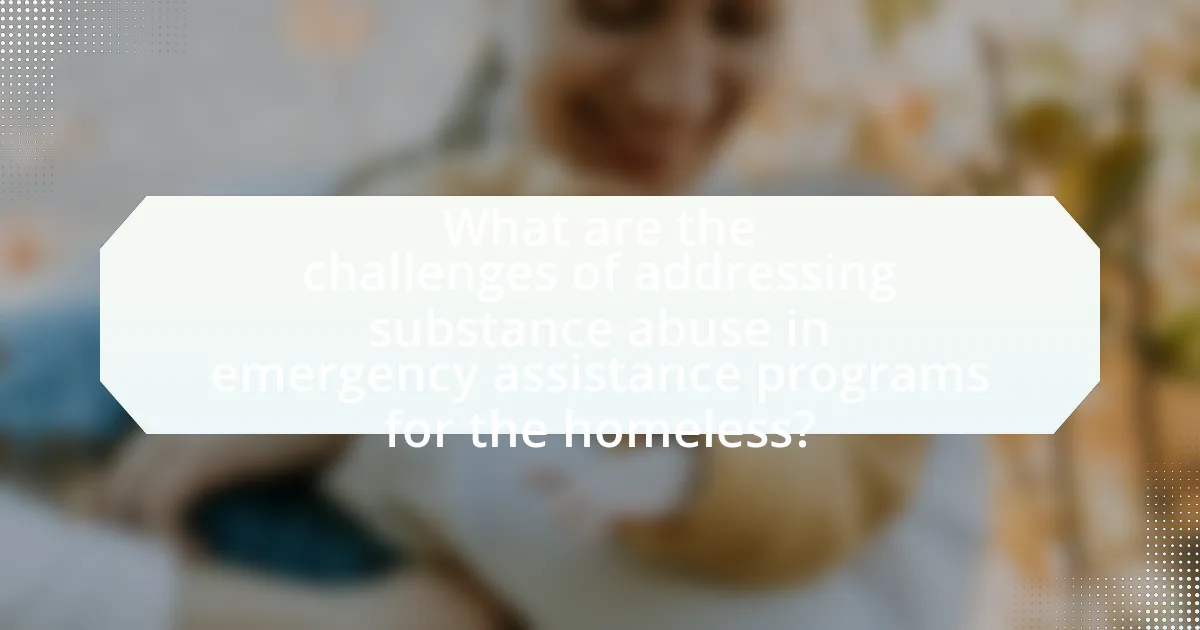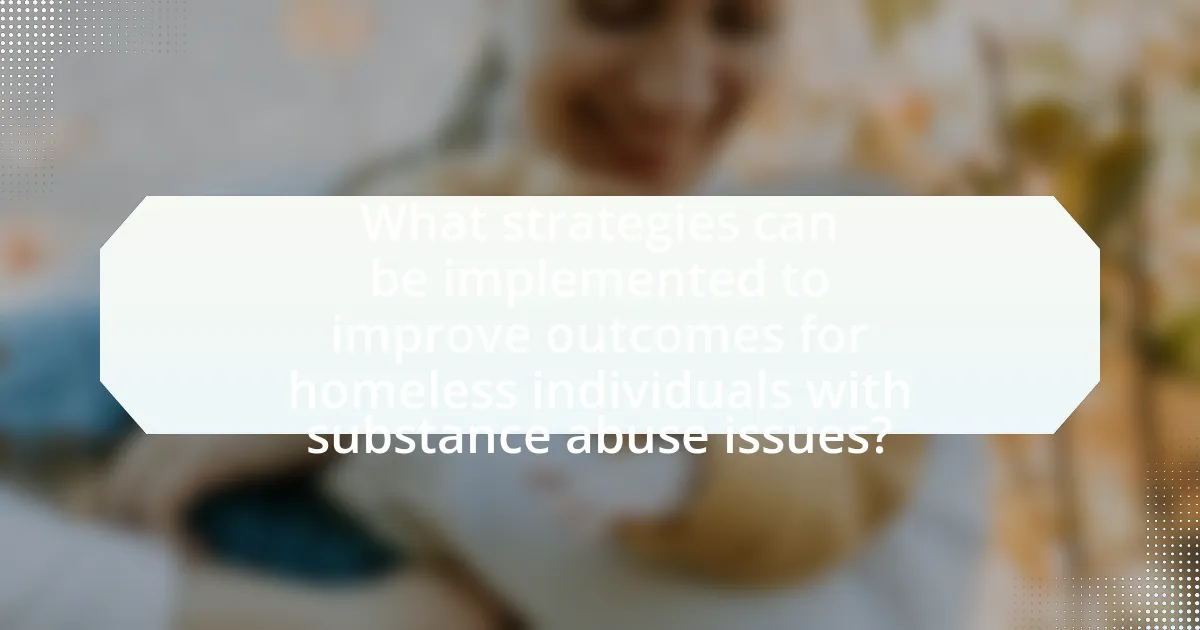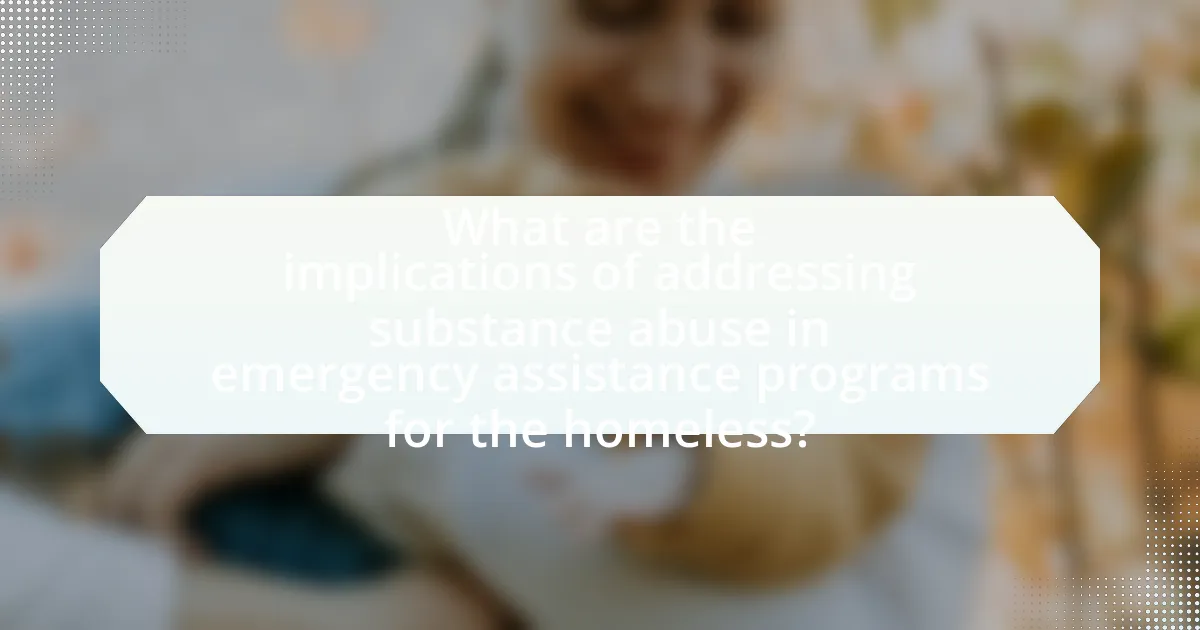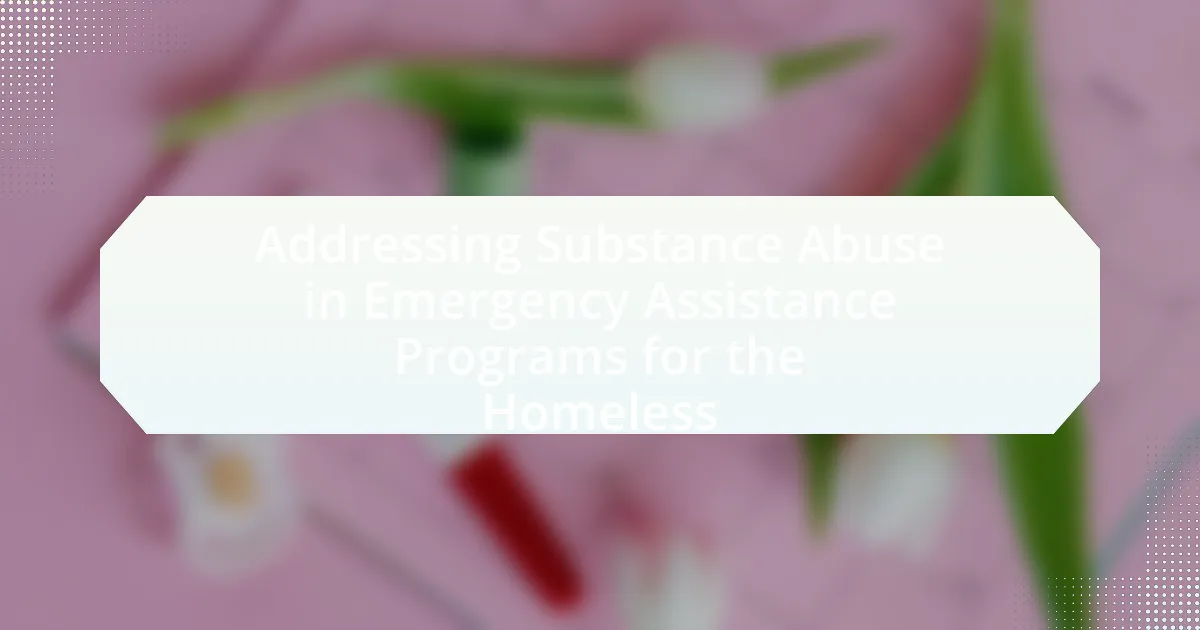The article focuses on the challenges of addressing substance abuse within emergency assistance programs for the homeless. It highlights the complexities of addiction, the stigma surrounding substance use, and the lack of integrated support services that hinder effective treatment. Key barriers faced by homeless individuals include discrimination, limited resources, and the transient nature of their living situations. The article also discusses the importance of integrating substance abuse treatment into emergency programs, the role of collaboration among agencies, and evidence-based practices that can improve health outcomes and stability for this vulnerable population. Ultimately, it emphasizes the need for comprehensive approaches to enhance recovery and reduce homelessness linked to substance abuse.

What are the challenges of addressing substance abuse in emergency assistance programs for the homeless?
Addressing substance abuse in emergency assistance programs for the homeless presents significant challenges, primarily due to the complexity of addiction and the need for integrated support services. Emergency programs often lack the resources to provide comprehensive treatment options, which can lead to high rates of relapse among individuals seeking help. For instance, a study by the Substance Abuse and Mental Health Services Administration (SAMHSA) indicates that only 10% of individuals with substance use disorders receive the necessary treatment, highlighting the gap in available services. Additionally, the stigma surrounding substance abuse can deter individuals from seeking assistance, further complicating their access to emergency programs. Furthermore, the transient nature of homelessness makes it difficult to establish consistent treatment plans, as individuals may move frequently between shelters and other temporary accommodations. These factors collectively hinder the effectiveness of emergency assistance programs in addressing substance abuse among the homeless population.
How does substance abuse impact the effectiveness of emergency assistance programs?
Substance abuse significantly undermines the effectiveness of emergency assistance programs by creating barriers to access and compliance. Individuals struggling with substance abuse often face challenges such as impaired decision-making, increased health risks, and social stigma, which can lead to lower participation rates in these programs. For instance, a study published in the Journal of Substance Abuse Treatment found that homeless individuals with substance use disorders were less likely to engage with emergency shelters and services, resulting in reduced overall program efficacy. Additionally, the presence of substance abuse can complicate the delivery of services, as staff may need to allocate more resources to manage crises related to addiction, thereby diverting attention from other critical support services.
What specific barriers do homeless individuals with substance abuse issues face in accessing services?
Homeless individuals with substance abuse issues face significant barriers in accessing services, including stigma, lack of integrated care, and limited availability of resources. Stigma associated with substance abuse often leads to discrimination from service providers, making it difficult for these individuals to seek help. Additionally, many services do not offer integrated care that addresses both homelessness and substance abuse, resulting in fragmented support systems. Furthermore, the scarcity of resources, such as affordable treatment programs and housing options, exacerbates the challenges faced by this population, limiting their ability to access necessary services effectively.
How does the stigma surrounding substance abuse affect program participation?
The stigma surrounding substance abuse significantly reduces program participation among individuals seeking help. This stigma often leads to feelings of shame and fear of judgment, which can deter individuals from accessing necessary services. Research indicates that approximately 60% of individuals with substance use disorders report avoiding treatment due to concerns about stigma (Corrigan, 2004). Consequently, this avoidance results in lower engagement in emergency assistance programs designed to support the homeless, ultimately hindering recovery efforts and perpetuating cycles of homelessness and substance abuse.
What role do emergency assistance programs play in addressing substance abuse?
Emergency assistance programs play a critical role in addressing substance abuse by providing immediate support and resources to individuals in crisis. These programs often offer access to essential services such as medical care, counseling, and rehabilitation, which are vital for individuals struggling with addiction. For instance, a study published in the Journal of Substance Abuse Treatment found that emergency shelters that incorporate substance abuse treatment services significantly improve recovery outcomes for homeless individuals. By addressing both immediate needs and underlying issues related to substance abuse, these programs facilitate pathways to long-term recovery and stability.
How can these programs integrate substance abuse treatment into their services?
Emergency assistance programs for the homeless can integrate substance abuse treatment into their services by incorporating on-site counseling, referral systems, and comprehensive case management. On-site counseling allows immediate access to trained professionals who can assess and address substance use issues as they arise. Referral systems can connect individuals to specialized treatment facilities, ensuring continuity of care. Comprehensive case management coordinates various services, including housing, healthcare, and substance abuse treatment, which has been shown to improve outcomes for individuals experiencing homelessness and substance use disorders. Research indicates that programs integrating these services can reduce substance use and improve housing stability, as evidenced by studies from the Substance Abuse and Mental Health Services Administration.
What are the best practices for emergency assistance programs to support individuals with substance abuse issues?
Emergency assistance programs should implement integrated treatment approaches as best practices to effectively support individuals with substance abuse issues. These programs must combine immediate assistance, such as shelter and food, with access to substance abuse treatment services, including counseling and rehabilitation. Research indicates that programs offering comprehensive support, like the Substance Abuse and Mental Health Services Administration’s (SAMHSA) guidelines, show improved outcomes for individuals facing homelessness and substance use disorders. Additionally, establishing partnerships with local healthcare providers and community organizations enhances resource availability and continuity of care, which is crucial for long-term recovery.

What strategies can be implemented to improve outcomes for homeless individuals with substance abuse issues?
To improve outcomes for homeless individuals with substance abuse issues, integrated treatment programs that combine mental health services, substance abuse treatment, and housing support should be implemented. Research indicates that programs offering a combination of these services lead to better recovery rates and housing stability. For instance, the Substance Abuse and Mental Health Services Administration (SAMHSA) reports that individuals receiving integrated care are more likely to achieve long-term sobriety and maintain stable housing compared to those receiving fragmented services. Additionally, harm reduction strategies, such as needle exchange programs and supervised consumption sites, have been shown to reduce the negative health impacts of substance use while encouraging individuals to seek further treatment. These approaches not only address immediate health concerns but also facilitate pathways to recovery and reintegration into society.
How can collaboration between agencies enhance support for this population?
Collaboration between agencies can enhance support for homeless individuals struggling with substance abuse by creating a comprehensive network of resources and services. When agencies work together, they can share information, streamline access to treatment programs, and coordinate care, which leads to more effective interventions. For instance, a study by the National Alliance to End Homelessness found that integrated service models, which involve collaboration among housing, health, and social service providers, significantly improve outcomes for homeless individuals with substance use disorders. This collaborative approach ensures that individuals receive not only immediate assistance but also ongoing support tailored to their specific needs, ultimately fostering recovery and stability.
What types of partnerships are most effective in addressing substance abuse among the homeless?
Collaborative partnerships between healthcare providers, social services, and community organizations are most effective in addressing substance abuse among the homeless. These partnerships facilitate comprehensive care by integrating medical treatment, mental health support, and housing assistance, which are crucial for recovery. For instance, programs like the Housing First model have demonstrated success by providing stable housing alongside access to addiction treatment, resulting in reduced substance use and improved overall well-being among participants. Research indicates that such integrated approaches lead to better health outcomes and lower rates of homelessness, highlighting the importance of collaboration in tackling substance abuse issues within this vulnerable population.
How can community resources be leveraged to provide comprehensive support?
Community resources can be leveraged to provide comprehensive support by integrating local services such as healthcare, housing assistance, and counseling into emergency assistance programs for the homeless. This integration ensures that individuals facing substance abuse issues receive holistic care that addresses both their immediate needs and underlying problems. For instance, studies show that programs combining housing with supportive services reduce substance use and improve overall health outcomes, as evidenced by the 2016 report from the National Alliance to End Homelessness, which highlights the effectiveness of coordinated care models in reducing homelessness and substance abuse. By utilizing existing community resources, emergency assistance programs can create a more effective support system that fosters recovery and stability for homeless individuals.
What evidence-based practices exist for addressing substance abuse in emergency settings?
Evidence-based practices for addressing substance abuse in emergency settings include the implementation of Screening, Brief Intervention, and Referral to Treatment (SBIRT), which has been shown to effectively identify and manage substance use disorders. Research indicates that SBIRT can reduce substance use and improve treatment engagement among individuals in emergency situations. Additionally, the use of motivational interviewing techniques has been validated as an effective approach to enhance individuals’ readiness to change their substance use behaviors. Studies demonstrate that these practices lead to better outcomes in emergency settings, particularly for vulnerable populations such as the homeless.
What are the key components of successful substance abuse intervention programs?
Successful substance abuse intervention programs typically include the following key components: comprehensive assessment, individualized treatment plans, family involvement, and ongoing support. Comprehensive assessment involves evaluating the individual’s substance use history, mental health status, and social circumstances to tailor interventions effectively. Individualized treatment plans are essential as they address the unique needs of each participant, enhancing engagement and outcomes. Family involvement is crucial, as it fosters a supportive environment and encourages accountability. Ongoing support, including aftercare services and community resources, helps maintain recovery and prevent relapse. Research indicates that programs incorporating these elements demonstrate higher success rates in achieving long-term sobriety and improved quality of life for participants.
How can data and research inform the development of these practices?
Data and research can inform the development of practices addressing substance abuse in emergency assistance programs for the homeless by providing evidence-based insights into the prevalence, patterns, and effective interventions for substance use disorders. For instance, studies such as “Substance Use Disorders and Homelessness: A Review of the Literature” published in the Journal of Substance Abuse Treatment highlight the correlation between homelessness and substance abuse, emphasizing the need for tailored interventions. Additionally, data analytics can identify specific demographics and trends, allowing programs to allocate resources effectively and implement targeted strategies that have been proven to reduce substance abuse rates among homeless populations.

What are the implications of addressing substance abuse in emergency assistance programs for the homeless?
Addressing substance abuse in emergency assistance programs for the homeless leads to improved health outcomes and increased stability for individuals. By integrating substance abuse treatment into these programs, homeless individuals are more likely to receive comprehensive care that addresses both their immediate needs and underlying issues. Research indicates that programs incorporating substance abuse services can reduce the rates of relapse and improve overall recovery outcomes, as evidenced by a study published in the Journal of Substance Abuse Treatment, which found that participants in integrated programs showed a 30% increase in successful treatment completion compared to those in standard programs. Furthermore, addressing substance abuse can enhance the effectiveness of housing-first initiatives, as stable housing is often contingent upon managing addiction, thereby reducing the cycle of homelessness.
How does addressing substance abuse improve overall health outcomes for homeless individuals?
Addressing substance abuse significantly improves overall health outcomes for homeless individuals by facilitating access to necessary medical care and reducing the incidence of co-occurring health issues. When substance abuse is treated, individuals are more likely to engage in health services, leading to better management of chronic diseases, mental health conditions, and infectious diseases. For instance, a study published in the American Journal of Public Health found that homeless individuals who received substance abuse treatment had a 30% reduction in emergency room visits and hospitalizations, indicating improved health stability. This connection underscores the importance of integrated treatment approaches that address both substance use and general health care needs for this vulnerable population.
What long-term benefits can be expected from effective substance abuse interventions?
Effective substance abuse interventions can lead to significant long-term benefits, including reduced rates of relapse, improved mental health, and enhanced social stability. Research indicates that individuals who participate in structured treatment programs experience a 40-60% reduction in substance use over time, which correlates with better overall health outcomes. Additionally, studies show that effective interventions can decrease criminal behavior by up to 80%, thereby fostering safer communities. Furthermore, long-term engagement in recovery programs is associated with increased employment rates, with some studies reporting a 50% increase in job retention among those who have completed treatment. These benefits collectively contribute to a decrease in healthcare costs and an increase in quality of life for individuals affected by substance abuse.
How does successful intervention impact community resources and costs?
Successful intervention in addressing substance abuse among the homeless significantly reduces community resources and costs. Effective programs lead to decreased emergency healthcare utilization, as individuals receive necessary treatment and support, resulting in lower hospital admissions and emergency room visits. For instance, a study by the National Institute on Drug Abuse found that every dollar spent on substance abuse treatment can save up to $7 in healthcare costs. Additionally, successful interventions can reduce the burden on social services and law enforcement, as individuals stabilize and reintegrate into society, leading to lower rates of crime and homelessness. This overall reduction in demand for community resources translates into substantial cost savings for local governments and taxpayers.
What practical steps can emergency assistance programs take to better address substance abuse?
Emergency assistance programs can implement integrated substance abuse treatment services to better address substance abuse among the homeless. By providing on-site counseling, medication-assisted treatment, and access to rehabilitation resources, these programs can directly support individuals struggling with addiction. Research indicates that integrated approaches significantly improve treatment outcomes; for instance, a study published in the Journal of Substance Abuse Treatment found that individuals receiving comprehensive services were 30% more likely to achieve long-term sobriety compared to those who did not. Additionally, training staff to recognize and respond to substance abuse issues can enhance the effectiveness of these programs, ensuring that individuals receive timely and appropriate care.
What training and resources do staff need to effectively support individuals with substance abuse issues?
Staff need specialized training in substance abuse treatment, mental health support, and trauma-informed care to effectively support individuals with substance abuse issues. This training should include understanding the nature of addiction, recognizing signs of substance use disorders, and implementing evidence-based intervention strategies. Resources such as access to counseling services, referral networks for rehabilitation programs, and ongoing professional development opportunities are essential. Research indicates that programs incorporating these elements significantly improve outcomes for individuals with substance abuse issues, as evidenced by studies showing a 30% increase in successful recovery rates when staff are adequately trained and supported.
How can programs measure the success of their substance abuse initiatives?
Programs can measure the success of their substance abuse initiatives by tracking key performance indicators such as reduction in substance use, improvement in health outcomes, and increased engagement in treatment services. For instance, studies show that programs utilizing evidence-based practices can achieve a 30% reduction in substance use among participants within six months, as reported by the Substance Abuse and Mental Health Services Administration. Additionally, follow-up assessments can evaluate changes in participants’ quality of life and social stability, providing concrete data on the effectiveness of the initiatives.

Leave a Reply